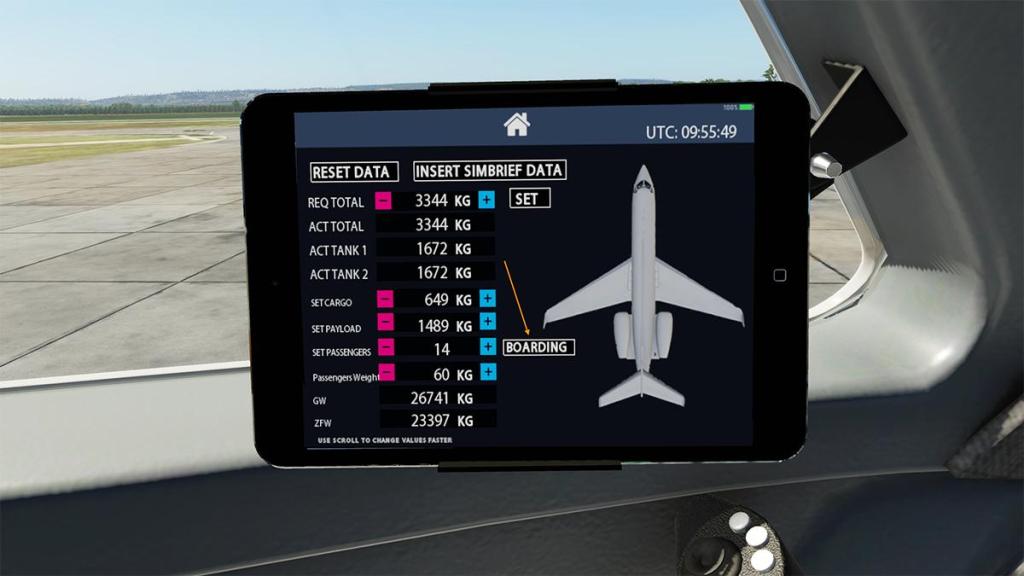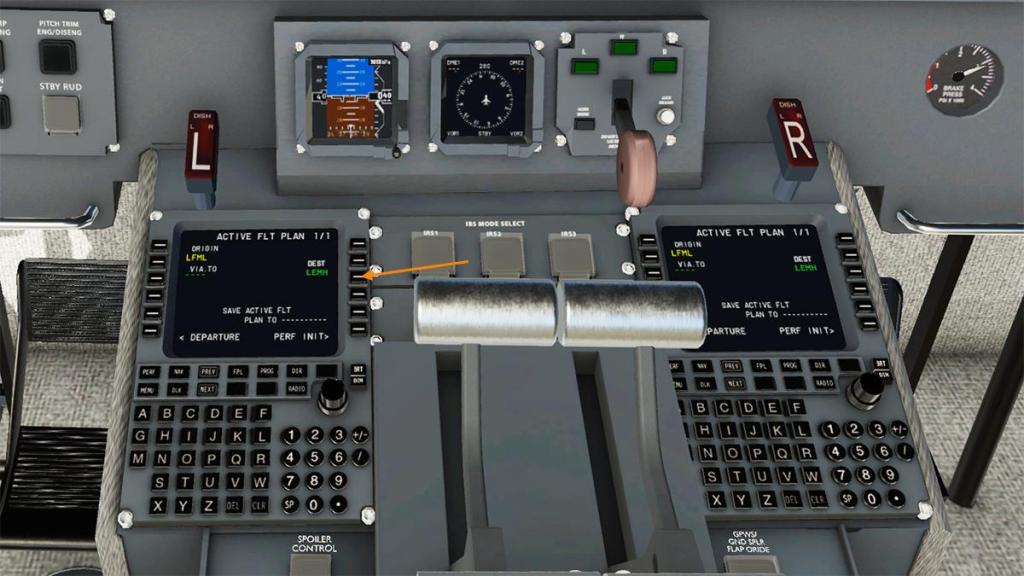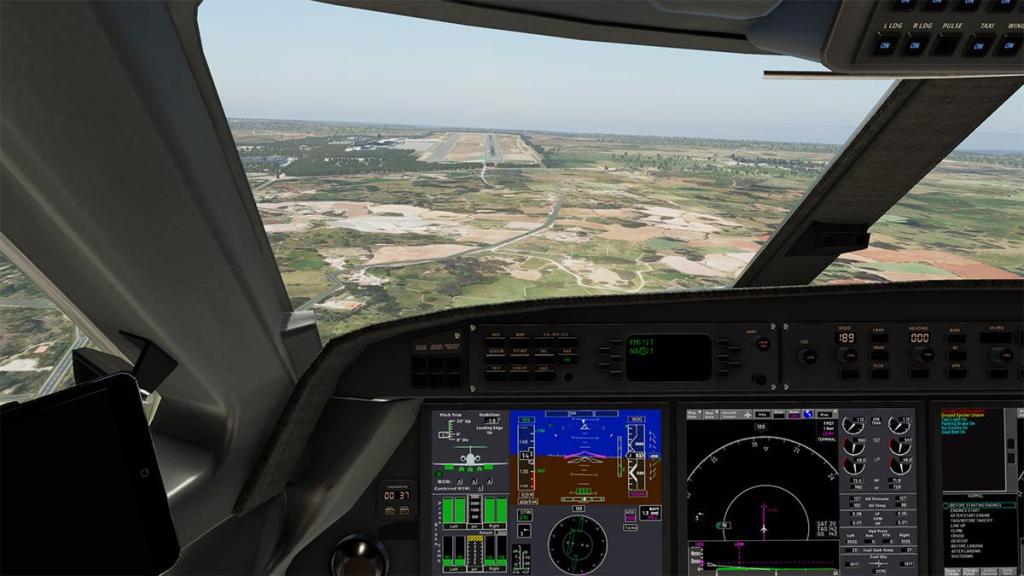Search the Community
Showing results for tags 'gulfstream'.
-
Aircraft Update Review : Gulfstream 550 by v2.05 by AKD Studio It's been less than a year since the release of the AKD Studio's GulfStream 550, and it feels like it has already been around a fair while. Most of that reason has been with the rapid and regular updates for the aircraft, 11 updates to date, so almost one a month, and throw in a v2 model version update as well. So this G550 is classified as a X-Plane 12 aircraft, and yes even an X-Plane 11 version is also supplied, but without the XP12 features and effects. With the huge amount of improvements over the last twelve months, the aircraft has come a long way, certainly systems wise, but also feature wise, but their are weaknesses in the modeling are still very visually present and not yet attended to, which we will get to. The latest update is v2.05 (Sept 29th), but we will also look at a few of the changes and note a few of the features of the earlier version v2 updates as well, outwardly it is now an impressive aircraft. We will start with a look at the latest changes in v2.05 First is another change to the 3D vehicle, the third since release? Originally we had a Telsla Model 3, but it was not to scale, and the vehicle was far too large in comparison to the G550, odd it was... in v1.10 you got another Tesla 3, to scale this time, but it was still odd, because you can't deliver 16 passengers and a flight crew to a jet in a five seater car? This time around in v2.05 we finally arrived at a better transport solution, a Mercedes Benz Sprinter bus. The new Sprinter is extremely well modeled, visually excellent, and the door opens when it arrives at the aircraft. The bus is activated via the "Boarding" hotspot on the "Fuel" page. Note the feature to input Simbrief Data from your generated Flight Brief, this will also note the amount of passengers to be boarded (up to 16). On using SimBrief you have to add in your SimBrief ID via the "Settings" page. There are also three speeds to load the aircraft with the (Fuel) and Passengers, Instant - Short - Real. On the centre console 60hz audio panel, a MASTER SWitch has been added to the panel (arrowed). All the switch covers have also been redone to make them easier to see (slightly cloudy) and to use. Last new v2.05 feature are the nice lights on the stairs. With the v2.0 update, the G550 came with a new custom MCDU (Multipurpose Control and Display Unit). You still have the choice of both the original Laminar Research FMS system or the newer custom version, and it is based on the Honeywell (MCDU-R) Multi-Function Control and Display Unit. The Laminar FMS is on the left, and the Honeywell is on the right. The major difference is the amount of depth between the two systems, and the use here is a bit different from the usual set up in procedures, so a bit of a guide (tutorial) is required. One annoyance is that the two MCDU panels don't pop-out? they are awkward to use with the MAP display for and inputting the data, as the key input buttons are not totally aligned with the input data lines. (so you have to count each time) First input is to set the aircraft's "POSITION INIT" or GPS reference. You click on KR2 (Key Right 2) to insert your current aircraft Coordinates, mine is LFML or Marseille Airport, the position is then shown on the MAP (MFD). MAP has to be set on the "A/C CENTRE" or PLAN in most MAP settings, this is done through the Gulfstream specific glareshield "Display Controller". That will insert your departure airport, so you will next need to insert your ARRIVAL airport (RK3) LEMH (Menorca Airport) on the opposite side RK3. My flightplan today is... LFML/31L N0502F280 VATI6N VATIR UN852 VERSO UL16 SARGO SARG5F LEMH/19 Then you select your DEPARTURE, with your Runway, Standard Instrument Departure Route (SID) and Via if required, this departure sequence is shown in a full list, if correct then press ACTIVATE and it is then inserted as the start of your Flightplan (FPL). If you have a 5 letter or 3 Waypoint as the next insert, then just input directly into the "VIA-TO"... but if it is an AIRWAY then the input is unusual from the normal procedure. The AIRWAY is inputted in the "VIA TO" as UN852.VERSO or in the AIRWAY number (UN852) . then the EXIT Waypoint (VERSO). And then the AIRWAY is inserted in the flightplan. Then you can continue to build your flightplan until you reach the STAR input... at this point the system goes a bit off script, as there is no ARRIVAL selection? You are diverted to the "PERFORMANCE INIT" or five pages of performance data to be filled in... including "Type" Aircraft, Climb - Cruise-Descent, STEP/Fuel, Altitude, Weight... once the PERF pages are filled in you can then CONFIRM INIT to activate all the performance data... Then the ARRIVAL option is now available... and you can now fill in your Runway (Approach) and STAR/TRANS options. Press ACTIVATE to insert the Arrival data. Another oddity, is that you have to insert in your arrival airport (LEMH) at the end of the flightplan, this then activates the PERF data and fills in the rest of the flightplan data, with all the correct Flight Levels (Altitude) It is a tricky system to learn and navigate, yes there are also a few (annoying) bugs in there, and it takes a little practise to be confident in using this style of custom MCDU, it is also slightly complex and unforgiving, compared to the usual Boeing or Airbus systems... Another quirk is if you want to see the whole or parts of your flightplan. There is no STEP option, but you can check your flightplan by going to the "Display Controller" (IN A/C CENTRE mode) and selecting NEXT (the PREV doesn't yet work), and that allows you then to move through the flightplan in a PLAN mode, you can also adjust the range as well to scale the flightplan to your liking. Other MCDU PERF modes include TAKEOFF, CLIMB, CRUISE, DESCENT and LANDING data, or input. (only Takeoff/Landing is shown) DIR (Direct), HOLD and PATTERN are all available, as is PROG (Progress), which we will see in flight. Looking at the v2.05 bug list, you can see the attention given to the MCDU, it's better obviously, but as noted it is also still a little buggy in use, mostly in selecting DEPARTURE when inputting "VIA TO"? Other bug fixes cover a lot of the lighting in the cockpit, bad SASL crashes, weight calculations, and cross-referencing between the EFB and MCDU, plus a few minor changes in the detail around the cockpit. v2.05 Bugs fixes: -Fixed SpeedBrake manipulator(XP11/XP12) -Fixed Cockpit lights in Cockpit(XP12) -Fixed MCDU sometimes not updating route(XP11/XP12) -Fixed MCDU not adding all VOR's from FMS file(XP11/XP12) -Fixed DU1 FULL HSI 360 indicator with IRS OFF(XP11/XP12) -Fixed: the values I enter do not match what the FMS says(XP11/XP12) -Fixed: “Pull Up” sounds warning bell remains even in cold and dark(XP11/XP12) -Fixed "Marching ants" on knobs 3D model(XP11/XP12) -Fixed gross weight calculations in MCDU(XP11/XP12) -Fixed: "When I have to change the arrival It does not delete all of the old fixes"(XP11/XP12) -Fixed SASL crash Fail to get parameter #2 (value)(XP11/XP12) -Fixed SASL crash "bad argument #1 to 'match' (string expected, got nil)"(XP11/XP12) -Fixed: STAR/APP insert function(XP12/XP11) -Fixed Minor MCDU bugs(XP12/XP11) -Fixed Minor bugs(XP12/XP11) So why do you want a Gulfstream 550? PERFORMANCE. When you have set up your MCDU, you can then import the data into the EFB (Electronic Flight Bag) or Tablet. Under the PERF CALculator, you can insert the "Takeoff Data" and the "Landing Data", you can also do it the other way around... set up the Takeoff parameters, or Landing parameters, and then send the data directly to the FMS. Private Jets are unique to Simulators, unique to fly as well... it's the power available to you under the throttles as it is simply phenomenal. Power up those two Rolls-Royce BR710 C4-11 engines that come with a 15,400 lbf (68.4 kN) takeoff rating... and you just GO, FAST. It's like trying to reign in a very fast racehorse, as you are mostly just along for the ride. On rotate you have to control the nose, as you have available an enormous climb rate of 3,650 feet per minute, and you can go almost straight up... So setting the trim correctly for Takeoff is essential, but also is the re-adjustment once you are in the air, the nose just wants to go up... and up. Handling wise the G550 is a big aircraft, it feels like a small regional jet, of which it is in many ways. But behind the controls it is very nice to fly, and the operation in here is all very Gulfstream with the well done authentic layout. I really do like the custon MCDU, tricky to programme, but easy to use once in the air... TIP... the Auto/Throttle ARM is on the throttle arms, and the autothrottle won't work if you don't arm it first. The Cockpit lighting has about 12 adjustment knobs, and on the release the lighting was a bit hit or miss. AKD has done a lot of work on the lighting in the three updates, and now it is very good, a few areas are obviously still in need some adjustment (Co-Pilot side), but otherwise it is now becoming very good. The under panel lighting is very nice at night, and can be dialed down for takeoff and landing. This generation of Gulfstream jets gives you a lot of space inside as they are 43.11 feet long by 7 feet wide by 6 feet tall giving it a total cabin volume of 1669 cubic feet, they are the crème de la crème of cabins in size and fitouts. They can carry a crew of four, 2 pilots, 0–2 attendants plus 14–19 passengers plus a payload 6,200 lb (2,812 kg). This cabin is HUGE, and the layout here is two sets of club seating (eight chairs) and two large rear sofas. Well done is the in-flight screen, showing the aircraft's position, altitude, speed and time. Well you can stay up high for a very long time with 6,750 nmi (7,770 mi, 12,500 km) range, with a High Speed Cruise: M0.85 at 41,000 ft (12,497 m) or the standard Long Range Cruise: M0.80 at 41,000 ft (12,497 m), the total Service ceiling is 51,000 ft (16,000 m), God that is almost as high as Concorde... impressive isn't it. Notable are still the visual modeling imperfections. The rear engine exhaust outlets are very basic, worse in being very noticeable on the expensive jet from the rear, I really don't like the cabin windows either, poorly done, with very poor tint modeling, you sit close to them when viewing from the cabin, and they are a maddening distraction. Lastly the no glass in the nosegear lights, modeled, but not finished... all should have been attended to by this on one year date. Does the G550 need a door between the cockpit and elite passengers in the back? I think so, certainly for this price. Going up, then descending, I used (tested) the Level Change or FLCH, Flight Level Change mode. It's quite violent, climbing at an easy 3,500 fpm, the G550 climbs upwards like no tomorrow, to the stated 28,000 ft, you are there within minutes... going down was worse at a minus 4100 fpm as you simply dropped out of the sky, and then recovered at around the set 6000 ft. It does work brilliantly well, but like a theme-park ride. I'm at Menorca in no time, under an hour's flying time, high express ride down the Mediterranean... the aircraft following the SARG5F STAR to Runway 19. I like the low-speed capabilities of the G550, with the barn door flaps right down, your approach speeds are around 140 knts. Such a low speed approach gives you time to set up the aircraft correctly... Hands and feet on, and you can position the aircraft exactly were you want to, the size is perfect, this is no GA to be blown around in, or not with the lumbering feel of a big heavy jet, is this the perfect size and weight? It's very gusty on approach, but the manual flying of this aircraft is easy, getting close to the runway and you let the efficient wings do a great upward ground effect, they support you, and also give you time to get the best flare position for landing... ... I have done a fair few flights now with the Gulfstream G550 to be now very comfortable with the aircraft, but to note have still not done a trans-continental or an ocean crossing, and in so using the full capabilities of what this aircraft can do. But it does always leave a smile on my face, and in wanting more. Finally there is a really excellent and long livery list, and some extras you can download for the AKD Design Gulfstream G550, you can find them here.... GLF550 by AKD - IMPORTANT LINKS AND INFORMATION - AKD Studio - G550 ___________ Summary Since being released a year ago in October 2023. The Gulfstream G550 by AKD Studios has had some significant updates in the meantime, including a complete v2.0 release. The v2.0 release included a custom Honeywell (MCDU-R) Multi-Function Control and Display Unit as part of the update, but also in the latest update v2.05, there were other new additions, including another new Car 3D Model? but this time a lovely Mercedes Sprinter bus, as they finally got it right. Also added is new Audio Panel and added new switches covers, also Lights have been added to the stairs of main cabin door, more significant is the long list of attention to bugs and fixes including lighting in the cockpit, bad SASL crashes, weight calculations, and cross-referencing between the EFB and MCDU, plus a few minor changes in the detail around the cockpit. In lots of ways the G550 aircraft has had an substantial amount of changes and features added in the past year, my only beef is some very visual modeling areas have not had attention in the same time period, rear exhaust outlets are very basic, poor cabin windows and visible non-glass on the front wheel strut are very glaring in their inattention. One of the best super long-distance trans-continental or ocean crossing private jets available for the X-Plane 12 Simulator (An X-Plane 11 version is also included) is this Gulfstream 550. Brilliant to fly and very authentic to the Gulfstream brand, and it comes with a very long feature list, it is available now to live out your perfect one-percenter ultra wealthy elite rich dreams, plus you also get to fly a very nice aircraft. _______________________________ The Gulfstream 550 v2.05 by AKD Studio is NOW available here at the X-Plane.OrgStore GLF550 - Ultimate Business Jet by AKD Studio Price is US$41.95 This aircraft is now both X-Plane12 and X-Plane 11 supported Requirements X-Plane 12 or X-Plane 11 Windows, Mac or Linux 4 GB VRAM Minimum - 8 GB+ VRAM Recommended Download Size: 1.1 GB Current version : 1.10 (February 7th 2023) Download for the Gulfstream 550 by AKD Studio is 1.03GB And the final install in X-Plane Aircraft folder with the above loaded liveries is; 2.53gb. Authorisation is required. The AviTab plugin is also required to use this aircraft, and it is deposited in your X-Plane Plugins folder. Simbrief proflie is; https://www.simbrief.com/system/dispatch.php?sharefleet=256234_1658264083720 The ADK Gulfstream G550 v2.05 update can be downloaded via the X-plane.OrgStore, or via the Skunkcrafts updater Documents AKD GLF550 Introduction.pdf FMS_Manual.pdf GLF550 Normal Checklist.pdf GLF550_air_conditioning_system.pdf GLF550_auxiliary_power_unit_(apu)_system.pdf GLF550_electrical_system.pdf GLF550_fire_protection_system.pdf GLF550_flight_control_system.pdf GLF550_fuel_system.pdf GLF550_hydraulic_system.pdf GLF550_ice_and_rain_protection_system.pdf GLF550_landing_gear_and_brakes_system.pdf GLF550_oxygen_system.pdf GLF550_pneumatic_system.pdf GLF550_powerplant_system.pdf GLF550_pressurization_system.pdf Changelog Included here are all the v2.0 changlogs... v2.0 - v2.02 - v2.03 and v2.05 Changelog v2.0 - v2.02 - v2.03 and v2.05.txt Designed by AKD Studios Support forum for the Gulfstream G550 _____________________ Aircraft Update Review by Stephen Dutton 11th October 2023 Copyright©2023: X-Plane Reviews Review System Specifications: Windows - 12th Gen IS1700 Core i7 12700K 12 Core 3.60 GHz CPU - 64bit -32 Gb single 1067 Mhz DDR4 2133 - PNY GeForce RTX 3080 10GB XLR8 - Samsung 970 EVO+ 2TB SSD Software: - Windows 11 Pro - X-Plane 12.01r3 (This is a beta review). Plugins: JustFlight-Traffic (X-Plane.OrgStore) US$52.99 : Global SFD plugin US$30.00 : RK Apps XPRealistic v2 - US$34.99 Scenery or Aircraft - LFML - Airport Marseille XP by Aerosoft - (X-Plane.OrgStore) - US$24.99 - LEMH - Airport Menorca XP by Aerosoft - (X-Plane.OrgStore) - US$23.99 (Disclaimer. All images and text in this review are the work and property of X-PlaneReviews, no sharing or copy of the content is allowed without consent from the author as per copyright conditions) All Rights Reserved












































































